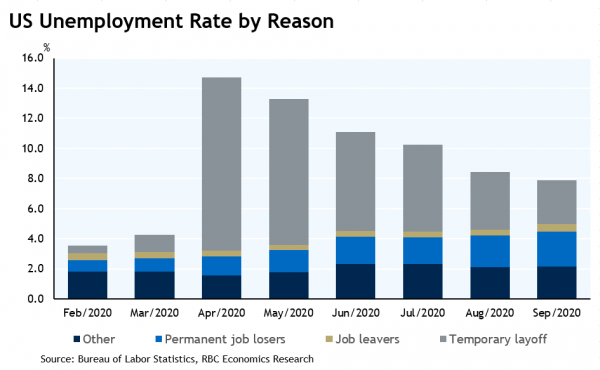- Non-farm payroll rose another 661k in September, undershooting expectations
- Unemployment rate fell to 7.9%
- Employment still down 10.7 million from February
Payroll employment added 661k jobs in September. That combined with gains over May to August, retraced just over 50% of the 22 million jobs lost earlier in the spring. Government employment fell 261k in September, mostly in local education. Outside the public sector, all 13 private industries added jobs, most notably in leisure and hospitality (318k) as well as retail trade (142k). Mining and logging employment ticked up for the first time in 7 months but employment remained sharply lower than its February level. Despite large gains in employment in prior months, the pace of the recovery has slowed on the back of still-weak conditions. As of September, there were still almost 11 million less jobs than there were in February, almost 4 million of which from leisure and hospitality alone. Hours worked also remained 7% below pre-COVID (February) levels in September.
After a sharp fall to 8.4% in August, the unemployment rate ticked lower again in September to 7.9%. Temporary layoffs continued to decline (-1.5 million) while the number of permanent job losers rose another 345k, to 3.8 million (compared to just 1.3 million in February.) Labour force participation unexpectedly ticker lower again in September. Though broader measures of labour force underutilization also improved. The U6 unemployment rate (which includes discouraged and involuntary part-time workers among others) fell a larger 1.4 percentage points than the half a percent drop in the official rate. The number of involuntary part-time workers dropped by a significant 1.3 million. And labour markets have continued to improve, even if at a slower pace. The number of people receiving jobless benefits fell another 980k in the week after the September payroll survey reference period.
